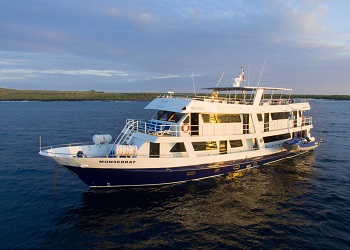Eden Itinerary 1 (A) - 5 Days
ITINERARY 1 (A) - 5 DAYS
SUNDAY
AM: Baltra: Arrival and Transfer to the boat
PM: Santa Cruz: Bachas Beach (HK/SN)
MONDAY
AM: Genovesa: Darwin Bay (HK/SN)
PM: Genovesa: Prince Philips Steps (HK/SN)
TUESDAY
AM: Bartolome (HK/SN/PR)
PM: Santiago: Sullivan Bay (HK/SN)
WEDNESDAY
AM: Santa Cruz: Black Turtle Cove (PR)
PM: Santa Cruz: Dragon hill (HK)
THURSDAY
AM: Santa Cruz: Charles Darwin Station (HK)
Baltra: Transfer to the Airport
HK: HIKE / SN: SNORKEL / PR: PANGA RIDE / KY: KAYAK /
PB: PADDLE BOARD
DAY 1: SUNDAY
AM: BALTRA ARRIVAL AND TRANSFER TO THE BOAT
Take an early flight to the Galápagos Islands. Head to Bachas Beach to see Sally Lightfoot crabs, flamingos and sea lions.
PM: SANTA CRUZ: BACHAS BEACH
Head to Bachas Beach where the sand is made of decomposed coral, making it soft and white, and a favourite site for nesting sea turtles. Spot abundant Sally Lightfoot crabs on the lava rocks along the water's edge -- these crabs will eat anything they can get their claws on! Trek to see a wide range of wildlife, including flamingos, hermit crabs, black necked stilts, and sea lions.
DAY 2: MONDAY
AM: GENOVESA: DARWIN BAY
Visit this sunken caldera for a great snorkelling opportunity. See large schools of tropical fish swarming near the vertical walls, and, if lucky, see a manta ray or hammerhead.
Walk along the white coral sands of Darwin Bay surrounded by bustling sea birds. Follow the trail and see nesting frigatebirds, gulls, and boobies. Be sure to bring your camera to take some snaps of your new feathered friends.
PM: GENOVESA: EL BARRANCO
Visit "El Barranco'' aka Prince Phillip's Steps located on the southern tip of the island for an amazing wildlife watching opportunity. Hike up the steps to see a seabird colony that is full of life including the breeding grounds for red-footed boobies and masked boobies.
DAY 3: TUESDAY
AM: BARTOLOMÉ ISLAND
Hike to Bartolomé's summit for a stronger perspective of the islands' not-too-distant volcanic origins, and enjoy a panoramic view – it’s one of the best among the islands! See other Galápagos Islands in the distance as well as Pinnacle Rock, the island’s famous towering landmark.
Take the opportunity to swim and snorkel around Pinnacle Rock, one of the most iconic volcanic rock formations on the islands. Home to Galápagos penguins, friendly sea lions, sea turtles, and a huge variety of fish, Bartolomé and its surrounding waters are a fantastic place to explore the natural wonders of the Galápagos.
PM: SULLIVAN BAY
Visit Sullivan Bay on Santiago Island to see one of its star natural attractions – striking and fascinating giant lava formations. Very few plants have managed to survive on this island due to its harsh environment and relatively new lava flow. Enjoy a walk along the lava formations before coming to a white-coral sand beach, where abundant Sally Lightfoot crabs and sea lions gather on shore.
DAY 4: WEDNESDAY
AM: SANTA CRUZ: BLACK TURTLE COVE
Explore the mangroves by panga to find rich marine wildlife between the fresh and salt waters. Keep any eye out for manta rays and sea turtles in this tranquil ecosystem. Whitetip reef sharks can also be seen gliding by.
PM: SANTA CRUZ: DRAGÓN HILL
Visit Cerro Dragón (Dragon Hill) for some prime birdwatching. Take a short walk from the beach to a hypersaline (saltier than the ocean) lagoon frequented by pink flamingos, common stilts, pintail ducks, and other species of birds. Pass through a Scalesia tree forest; endemic to the area, there are only 400 specimens of Scalesia trees left in the world.
DAY 5: THURSDAY
AM: SANTA CRUZ: CHARLES DARWIN - BALTRA TRANSFER TO THE AIRPORT
Visit Fausto Llerena Breeding Center a great place to observe many species of tortoises and land iguanas in captivity. Brought back from the brink of extinction, see the famous Galápagos tortoise up close – a corral houses adult tortoises, and a nursery cares for the young until around age three when their shells have hardened.
This area also houses the Charles Darwin Research Station, a scientific organization initiated in 1964, which works to preserve the Galápagos' ecosystem through the conservation efforts of scientists, researchers, and volunteers. While the offices themselves are not open to visitors, the research station provides a study location for international scientists and environmental education for the local community.







